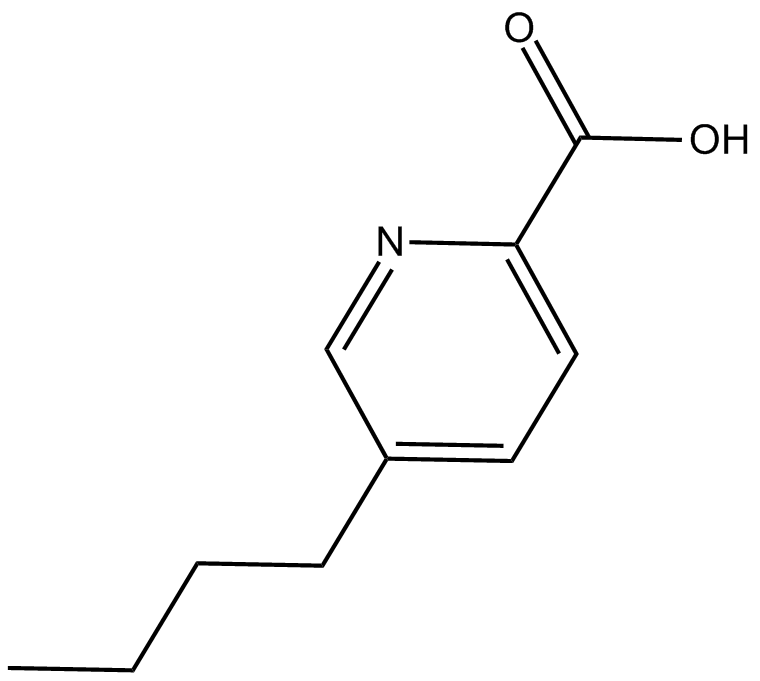Fusaric Acid (Synonyms: 5-Butylpicolinic Acid,5-Butylpyridine-2-Carboxylic Acid,NSC 135043) |
| Catalog No.GC18061 |
Fusaric acid, as a mycotoxin produced by the Fusarium species, has diverse toxicological effects in plants and animals.
Products are for research use only. Not for human use. We do not sell to patients.

Cas No.: 536-69-6
Sample solution is provided at 25 µL, 10mM.
Fusaric acid, as a mycotoxin produced by the Fusarium species, has diverse toxicological effects in plants and animals.[1]
In vitro, treatment with 104 µg/ml fusaric acid in human hepatocellular carcinoma (HepG2) cells post-translationally activates p53 in response to DNA damage.[2] In vitro efficacy test it shown that in HepG2 cells fusaric acid remarkably increased p53 promoter methylation in the 25, 104, and 150 µg/ml fusaric acid treatments; but in the 50 µg/ml fusaric acid treatment significantly decreased the promoter methylation of p53. [1] In HepG2 cells, fusaric acid dramatically increased promoter methylation of DNMT1 compared to the control; however, treatment with 25, 50, and 104 µg/ml fusaric acid decreased the promoter methylation of DNMT3A and treatment with 150 µg/ml increased the promoter methylation of DNMT3A.[3] Fusaric acid has toxicity (24 h incubation; IC50 = 104 μg/ml) on mitochondrial output, cellular and mitochondrial stress responses, mitochondrial biogenesis and markers of cell death.[4] In addition, fusaric acid has cytotoxicity to PBMCs with IC50 of 240.8 μg/ml and Thp-1 with IC50 of 107.7 μg/ml cells at 24 h.[5]
In vivo experiment it indicated that treatment with 100 mg/kg body weight fusaric acid intraperitoneally 30 min prior to the onset of the dark phase (lights out) in rats increased the level of brain serotonin (5HT), 5-hydroxyindoleacetic acid (5HIAA), tyrosine (TYRO), and dopamine (DA) and decreased the level of norepinephrine (NEpi).[6]
References:
[1]Ghazi T, et al. Fusaric acid decreases p53 expression by altering promoter methylation and m6A RNA methylation in human hepatocellular carcinoma (HepG2) cells. Epigenetics. 2021 Jan;16(1):79-91.
[2]Ghazi T, Nagiah S, Tiloke C, et al. Fusaric acid induces DNA damage and post‐translational modifications of p53 in human hepatocellular carcinoma (HepG2) cells. J Cell Biochem. 2017. November;118(11):3866–3874.
[3]Ghazi T, et al. Fusaric acid-induced promoter methylation of DNA methyltransferases triggers DNA hypomethylation in human hepatocellular carcinoma (HepG2) cells. Epigenetics. 2019 Aug;14(8):804-817.
[4]Sheik Abdul N, et al. Fusaric acid induces mitochondrial stress in human hepatocellular carcinoma (HepG2) cells. Toxicon. 2016 Sep 1;119:336-44.
[5]Dhani S, et al. Fusaric Acid immunotoxicity and MAPK activation in normal peripheral blood mononuclear cells and Thp-1 cells. Sci Rep. 2017 Jun 8;7(1):3051.
[6]Porter JK, et al. Fusaric acid in Fusarium moniliforme cultures, corn, and feeds toxic to livestock and the neurochemical effects in the brain and pineal gland of rats. Nat Toxins. 1995;3(2):91-100.
Average Rating: 5 (Based on Reviews and 29 reference(s) in Google Scholar.)
GLPBIO products are for RESEARCH USE ONLY. Please make sure your review or question is research based.
Required fields are marked with *




















